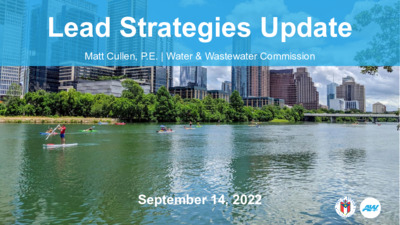Item 8 — original pdf
Backup

Lead Strategies Update Matt Cullen, P.E. | Water & Wastewater Commission September 14, 2022 Agenda Background/Austin’s history EPA’s Lead and Copper Rule Revisions Lead Service Line Inventory Federal Funding for Lead Related Work Additional Requirements: School and Child Care Facility Education and Sampling EPA’s Lead and Copper Rule Revisions (LCRR) Goal: Further reduce exposure to lead in drinking water Final LCRR regulations issued on January 15, 2021 Placed under federal review until December 16, 2021, when made effective Current LCRR compliance date for water systems: October 16, 2024 • Complete Lead Service Line Inventory facilities over five-year period • Begin mandatory public education activities and coordination of lead sampling for schools & childcare EPA is preparing Lead and Copper Rule Improvement to be released prior to October 2024 Lead Service Line Inventory Lead pipe Identify water service line materials • Includes public and private service line Categorize service line material • Non-lead • Lead • Lead Status Unknown • Galvanized Requiring Replacement Complete by October 16, 2024 and submit to TCEQ AW Goal: All service lines in “non-lead” category Lead Service Line Inventory Meters in AW’s System • Total – 252,000 • Non-lead due to age – 196,000 • Non-lead due to field investigation – 17,350 • Galvanized – 1,350 • Still to be field investigated – 37,300 On track to be complete by late 2023/ early 2024 Public Side Materials 1,350 37,300 213,350 Not Lead TBD Galvanized Private Side Materials 700 37,300 214,000 Not Lead TBD Galvanized Federal Funding for Lead Related Work Funding allotted in the 2021 Bipartisan Infrastructure Law (BIL) through the Drinking Water State Revolving Fund (DWSRF) AW submitted the galvanized service replacement program to Texas Water Development Board (TWDB) for funding, but the project was not selected. AW continuously analyzes projects for potential DWSRF funding. AW is tracking costs for developing inventory, future school and childcare sampling, and potential galvanized service replacements. School & Child Care Facility Activities Regulatory requirements beginning as of October 16, 2024: Provide lead education materials to all schools and licensed childcare facilities • Health risk information • EPA’s 3Ts for Reducing Lead in Drinking Water Toolkit Coordinate and schedule for lead sampling of facilities between Oct. 2024 – Oct. 2029 • Required for all elementary schools and childcare facilities • Upon request for secondary schools • Not required for buildings constructed after 2013 • Facilities can decline sampling activity • 20% of elementary schools and childcare facilities per year • 5 samples per school, 2 samples per childcare facility AW provides sampling instructions, bottles, lab analysis, and reporting of results • School/facility staff can collect samples • Procedures based on EPA’s 3Ts guidance School & Child Care Facility Activities AW has previously researched the water lines serving schools and childcare facilities and found no lead piping In the meantime, AW is: Available as a resource for information and guidance for facilities Compiling a list of schools and childcare facilities served Developing a communication plan for engaging stakeholders Creating education and guidance materials Planning for staffing resources Remaining in compliance with current lead regulations • Most recent round of compliance sampling in 2021 had a lead 90th percentile value of 0.0 mg/L Free voluntary program launched by TCEQ in September 2022 • Open to all schools and childcare facilities • Parents and community members can nominate Customer Requested Lead Sampling Information available at: www.austintexas.gov/lead Includes contact information to request testing. Summary AW customers are at very low risk of exposure to lead through water: • Lack of lead services in AW’s system and in private plumbing • AW’s treatment and water characteristics AW is well positioned to be in compliance with the LCRR ahead of schedule: • Currently providing testing as-requested in addition to required routine testing • Service line inventory well underway • No need for lead service line replacement program (replace as found) • Preparing for school and childcare facility sampling program now